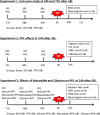Multiple mechanisms underlying neuroprotection by secretory phospholipase A2 preconditioning in a surgically induced brain injury rat model
- PMID: 29074417
- PMCID: PMC5745263
- DOI: 10.1016/j.expneurol.2017.10.022
Multiple mechanisms underlying neuroprotection by secretory phospholipase A2 preconditioning in a surgically induced brain injury rat model
Abstract
Background: Intra-operative bleeding, post-operative brain edema and neuroinflammation are major complications in patients with surgical brain injury (SBI). Phospholipase A2 (PLA2) is the upstream enzyme which initiates the PLA2, 5-lipoxygenase (5-LOX) and leukotriene B4 (LTB4) inflammatory pathway. We hypothesized PLA2preconditioning (PPC) prior to SBI can activate endogenous anti-inflammatory responses to protect against SBI. This study evaluated if PPC can ameliorate neurosurgical complications and elucidated PPC-mediated possible protective mechanisms in a rat SBI model.
Methods: Total 105 adult male Sprague Dawley rats were used for this study. SBI was induced by partial resection of the right frontal lobe. PLA2 or 0.9% NaCl was injected via rats' tail vein for 3 consecutive days prior to SBI. For mechanism study, a selective PLA2 inhibitor, Manoalide and 5-LOX inhibitor, Zileuton were injected intravenously with PPC to elucidate the role of PLA2 and 5-LOX in PPC-mediated anti-inflammatory effects. Brain water content (BWC) and lung water content, neurological tests, ELISA, western blot, immunohistochemistry, white blood cells (WBC) count, and spectrophotometric assay for intra-operative hemorrhage volume were evaluated.
Results: First, PPC reduced brain water content, intra-operative bleeding, and improved neurological function after SBI. Second, PPC decreased 5-LOX expression and brain leukocyte infiltration, while increasing glial fibrillary acidic protein (GFAP) expression in the peri-resection brain tissue after SBI. Third, PPC induced peripheral inflammation represented by mild pulmonary inflammation and increased peripheral blood WBC count and LTB4 level. Lastly, PPC increased blood glucose concentration and glucocorticoid levels after SBI. In addition, PPC mediated above-mentioned changes were partially reversed by administration of PLA2 inhibitor, Manoalide and 5-LOX inhibitor, Zileuton.
Conclusions: PPC conferred neuroprotection against SBI via multi-target involvement induced anti-inflammatory mechanisms.
Keywords: Brain edema; Intra-operative hemorrhage; Neuroinflammation; Preconditioning; Surgical brain injury; sPLA2.
Copyright © 2017 Elsevier Inc. All rights reserved.
Conflict of interest statement
The authors declare no competing financial interests.
Figures









Similar articles
-
Naja sputatrix Venom Preconditioning Attenuates Neuroinflammation in a Rat Model of Surgical Brain Injury via PLA2/5-LOX/LTB4 Cascade Activation.Sci Rep. 2017 Jul 14;7(1):5466. doi: 10.1038/s41598-017-05770-7. Sci Rep. 2017. PMID: 28710425 Free PMC article.
-
Crotalus helleri venom preconditioning reduces postoperative cerebral edema and improves neurological outcomes after surgical brain injury.Neurobiol Dis. 2017 Nov;107:66-72. doi: 10.1016/j.nbd.2017.03.001. Epub 2017 Mar 9. Neurobiol Dis. 2017. PMID: 28286182 Free PMC article.
-
Neurotrophin-3 provides neuroprotection via TrkC receptor dependent pErk5 activation in a rat surgical brain injury model.Exp Neurol. 2018 Sep;307:82-89. doi: 10.1016/j.expneurol.2018.06.002. Epub 2018 Jun 5. Exp Neurol. 2018. PMID: 29883578 Free PMC article.
-
Phosphoinositide 3-Kinase Gamma Contributes to Neuroinflammation in a Rat Model of Surgical Brain Injury.J Neurosci. 2015 Jul 22;35(29):10390-401. doi: 10.1523/JNEUROSCI.0546-15.2015. J Neurosci. 2015. PMID: 26203135 Free PMC article.
-
Neuroprotection against surgically induced brain injury.Surg Neurol. 2007 Jan;67(1):15-20; discussion 20. doi: 10.1016/j.surneu.2006.07.014. Surg Neurol. 2007. PMID: 17210286 Free PMC article. Review.
Cited by
-
Targeting gut dysbiosis as a means to enhance recovery from surgical brain injury.Surg Neurol Int. 2021 May 3;12:210. doi: 10.25259/SNI_72_2021. eCollection 2021. Surg Neurol Int. 2021. PMID: 34084637 Free PMC article. Review.
-
Neutrophil Extracellular Traps Regulate Surgical Brain Injury by Activating the cGAS-STING Pathway.Cell Mol Neurobiol. 2024 Apr 18;44(1):36. doi: 10.1007/s10571-024-01470-9. Cell Mol Neurobiol. 2024. PMID: 38637346 Free PMC article.
-
The Activation of Phosphatidylserine/CD36/TGF-β1 Pathway prior to Surgical Brain Injury Attenuates Neuroinflammation in Rats.Oxid Med Cell Longev. 2020 Aug 11;2020:4921562. doi: 10.1155/2020/4921562. eCollection 2020. Oxid Med Cell Longev. 2020. PMID: 32849998 Free PMC article.
-
Neuroprotective effect of phospholipase A2 from Malaysian Naja sumatrana venom against H2O2-induced cell damage and apoptosis.Front Pharmacol. 2022 Oct 14;13:935418. doi: 10.3389/fphar.2022.935418. eCollection 2022. Front Pharmacol. 2022. PMID: 36313292 Free PMC article.
-
Surgically-induced brain injury: where are we now?Chin Neurosurg J. 2019 Dec 16;5:29. doi: 10.1186/s41016-019-0181-8. eCollection 2019. Chin Neurosurg J. 2019. PMID: 32922928 Free PMC article. Review.
References
-
- Abd-Elfattah AS, Wechsler AS. Myocardial preconditioning: a model or a phenomenon? J Card Surg. 1995;10:381–8. - PubMed
-
- Arce-Bejarano R, et al. Intravascular hemolysis induced by the venom of the Eastern coral snake, Micrurus fulvius, in a mouse model: identification of directly hemolytic phospholipases A2. Toxicon. 2014;90:26–35. - PubMed
-
- Auriat A, et al. 17 beta-estradiol pretreatment reduces bleeding and brain injury after intracerebral hemorrhagic stroke in male rats. Journal of Cerebral Blood Flow and Metabolism. 2005;25:247–256. - PubMed
-
- Baba T, et al. Intracarotid infusion of leukotriene C4 selectively increases blood-brain barrier permeability after focal ischemia in rats. J Cereb Blood Flow Metab. 1991;11:638–43. - PubMed
-
- Barone FC, et al. Time-related changes in myeloperoxidase activity and leukotriene B4 receptor binding reflect leukocyte influx in cerebral focal stroke. Mol Chem Neuropathol. 1995;24:13–30. - PubMed
Publication types
MeSH terms
Substances
Grants and funding
LinkOut - more resources
Full Text Sources
Other Literature Sources
Miscellaneous

